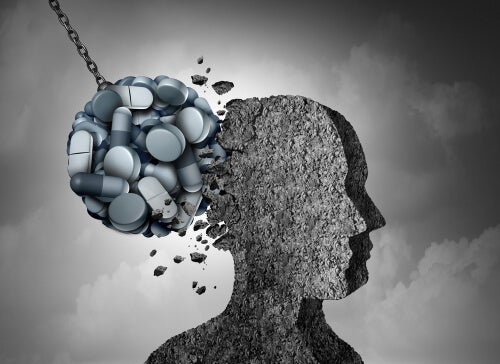The Role of Dynorphins: Opioid Neurotransmitters

For the past four decades, experts have discovered more about the important influence and role of dynorphins in the pathways of the human brain. They’re members of the opioid peptide family, which bind to kappa opioid receptors.
They’re localized in well-known areas of the brain: the hippocampus, amygdala, hypothalamus, striatum, and spinal cord. Thus, their functions are related to learning and memory, emotional control, stress response, and pain.
After a variety of experiments, experts began to discover the implications of dynorphins in human physiology. As a result, we now know that the pathophysiological mechanisms that may involve dynorphins include epilepsy, addiction, depression, and schizophrenia.
In 1979, Goldstein and his colleagues described the opioid properties of a tridecapeptide. To describe its extraordinary potency, the naturally occurring peptide was named dynorphin. The prefix dyn comes from the Greek word dynamis (power) and the -phin suffix indicates its opioid nature.

The role of dynorphins
Dynorphins in epilepsy
In the 1980s and 1990s, there were a considerable number of studies on the roles of dynorphins in different epilepsy models. Because of their distribution, experts thought they were more likely to act in complex partial seizures originating in the limbic system, or, to be more exact, in the hippocampus.
Since then, kappa opioid receptor stimulation has been accepted as an anticonvulsant mechanism. However, researchers only discovered these anticonvulsant properties of endogenous dynorphins on mice.
Dynorphins and addiction
The dynorphin/kappa-opioid receptor system plays a crucial role in reward and addiction mechanisms. Difficulties in the regulation of the dynorphin/kappa opioid receptor system are caused by repeated drug abuse and involve the mesolimbic reward system.
Thus, experts consider the dopaminergic pathway from the ventral tegmental area to the nucleus accumbens to be the main area where dynorphins act in the context of addiction.
Dynorphins in emotional control
Although we know quite a lot about the relationship between dynorphins and emotional control, there’s still a lot to discover. This is because testing emotions in animals isn’t as straightforward as EEG recordings.
Anxiety
We can see different manifestations of anxiety in many living beings. In a biological context, anxiety prepares the individual to face a potential threat. As a result, heart rate, body temperature, and serum corticosterone levels increase.
In addition, anxiety disorders often occur in parallel with other mental health problems, such as depression, addiction, and schizophrenia. Here, we can see that anxiety behaviors involve several neurotransmitter systems.
Along with the classical transmitters serotonin and noradrenaline, experts have proposed several neuropeptides as being modifiers of anxiety-related behavior. Among these, we find dynorphins.
Although their role isn’t very clear, we know that dynorphins have an association with anxiety. Getting a clear idea of how they’re related would require further research and analysis of conditional deletion models. These models allow the deletion of specific cells or regions in order to determine the roles of dynorphins in different brain nuclei.
Dynorphins and stress
Dynorphins also play a role in the occurrence of stress. This is due to their strong interrelationship with corticotropin-releasing hormone (CRH).

Dynorphin and psychotic disorders
Dynorphins and depression
We often view depression as a disease related to an inability to adapt to chronic stress. Although there are many treatments for this disorder, virtually all of them target the serotonergic and/or noradrenergic systems.
Dynorphins and opioid receptor-kappa receptors have been shown to influence virtually all of the circuits that experts consider to have a clear link to depression. Generally, the activation of opioid kappa-receptors seems to favor the onset of depression.
Dynorphins and schizophrenia
There’s increasing evidence for the possible involvement of dynorphins and kappa-opioid receptors in schizophrenia. However, we need more research in order to determine the precise relationship in this area.
While it’s true that experts need to further study the matter, the involvement of dynorphins in multiple mental disorders seems clear. Although their role in some disorders is still unclear, we know that their activation, along with kappa opioid receptors, is related to illnesses such as these.
All cited sources were thoroughly reviewed by our team to ensure their quality, reliability, currency, and validity. The bibliography of this article was considered reliable and of academic or scientific accuracy.
-
Schwarzer, C. (2009). 30 years of dynorphins—new insights on their functions in neuropsychiatric diseases. Pharmacology & therapeutics, 123(3), 353-370.
-
Houser, C. R., Miyashiro, J. E., Swartz, B. E., Walsh, G. O., Rich, J. R., & Delgado-Escueta, A. V. (1990). Altered patterns of dynorphin immunoreactivity suggest mossy fiber reorganization in human hippocampal epilepsy. Journal of Neuroscience, 10(1), 267-282.
-
Shippenberg, T. S., Zapata, A., & Chefer, V. I. (2007). Dynorphin and the pathophysiology of drug addiction. Pharmacology & therapeutics, 116(2), 306-321.
This text is provided for informational purposes only and does not replace consultation with a professional. If in doubt, consult your specialist.








